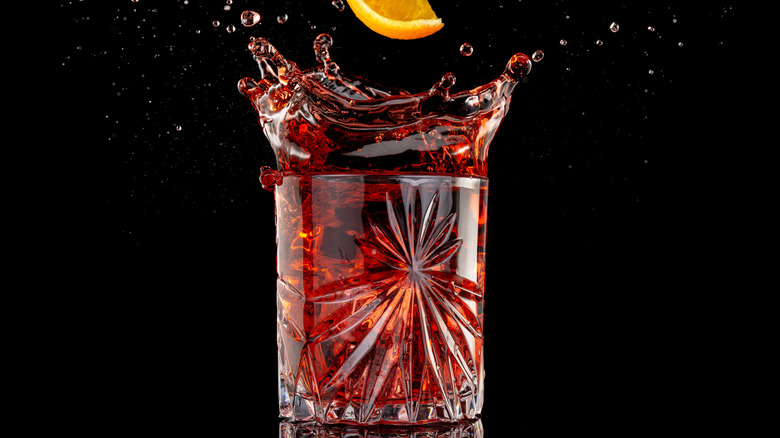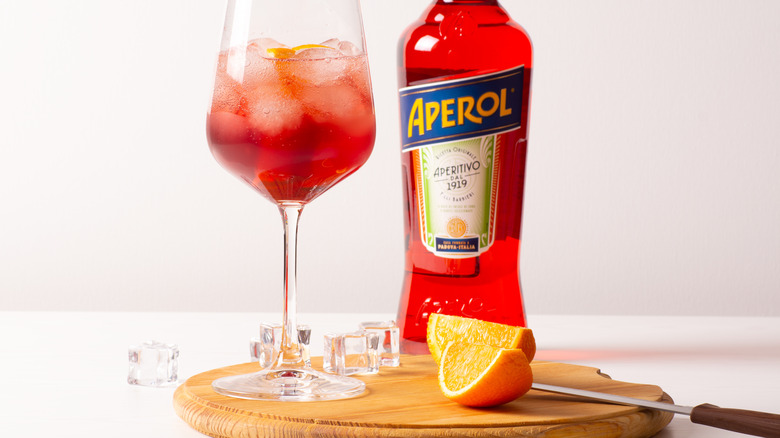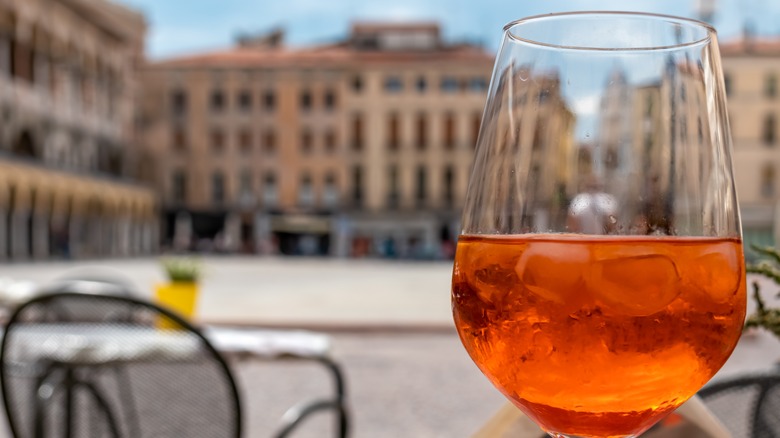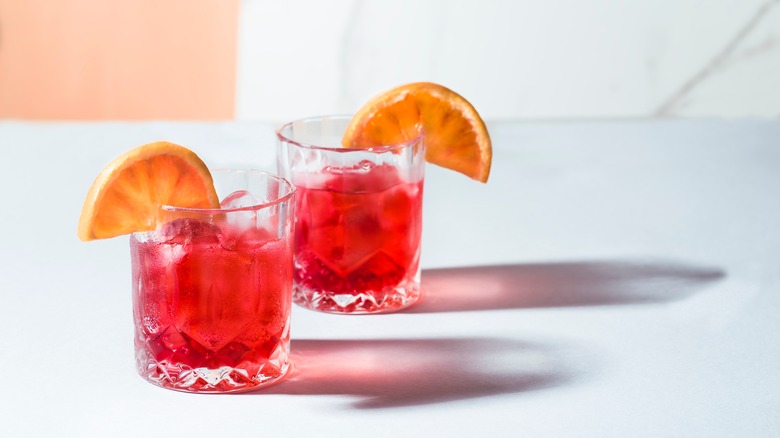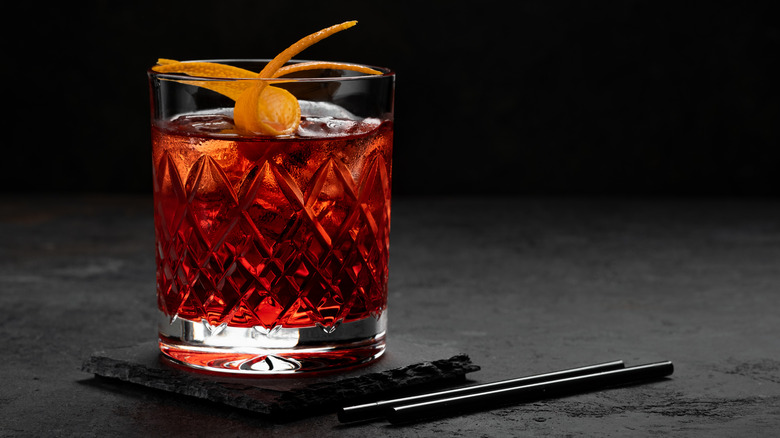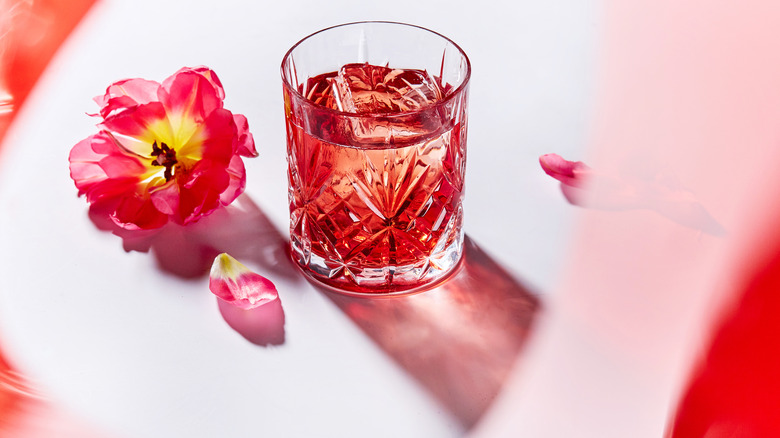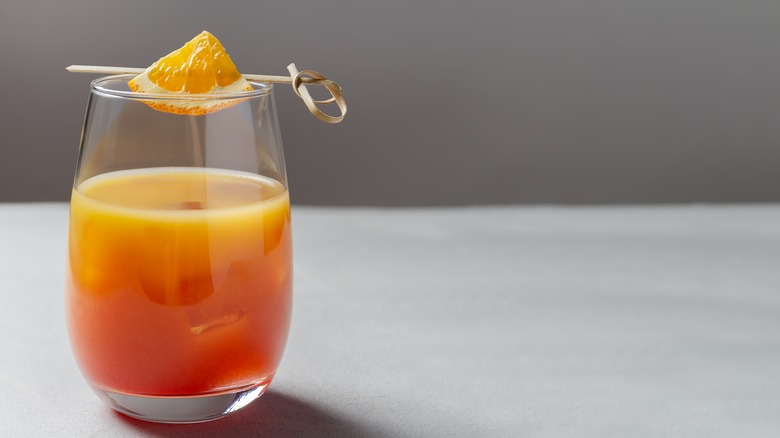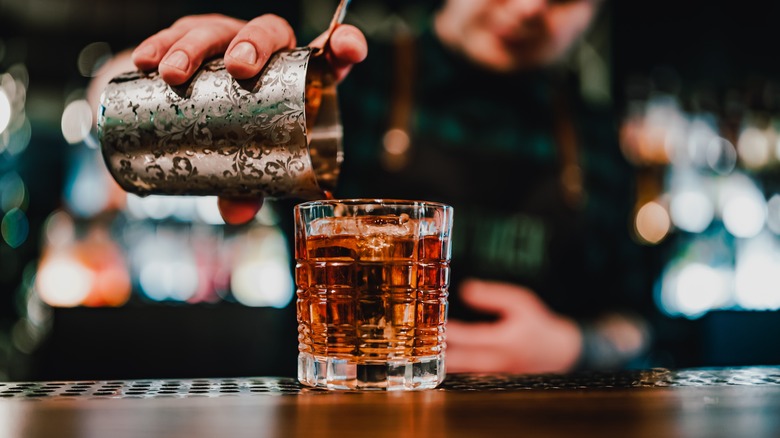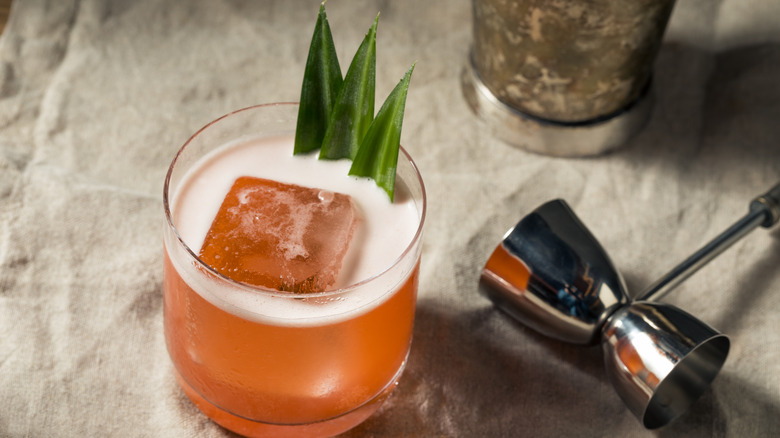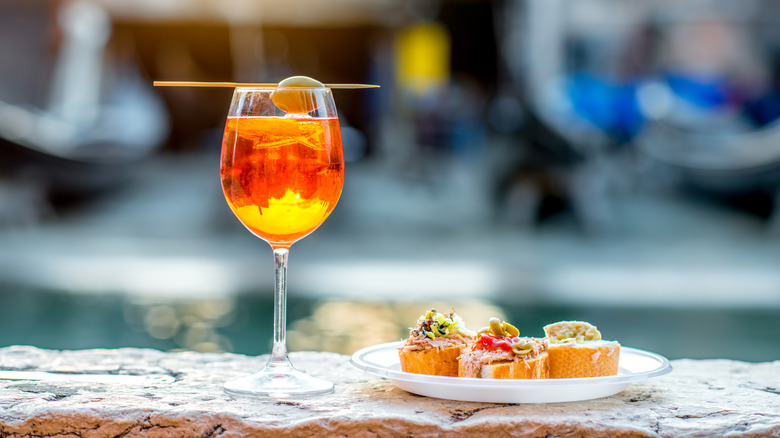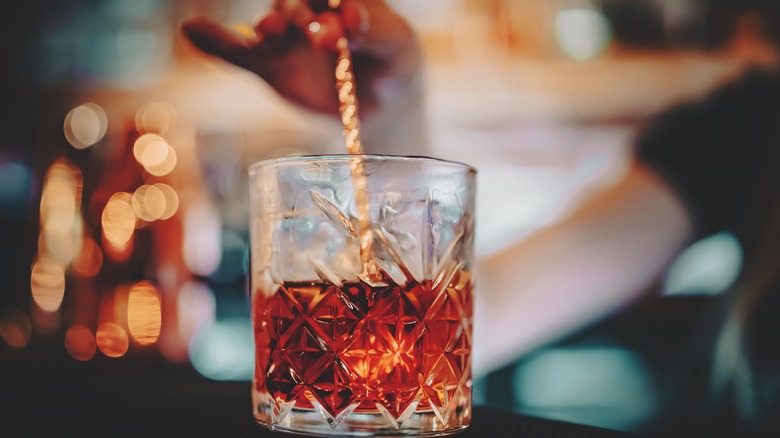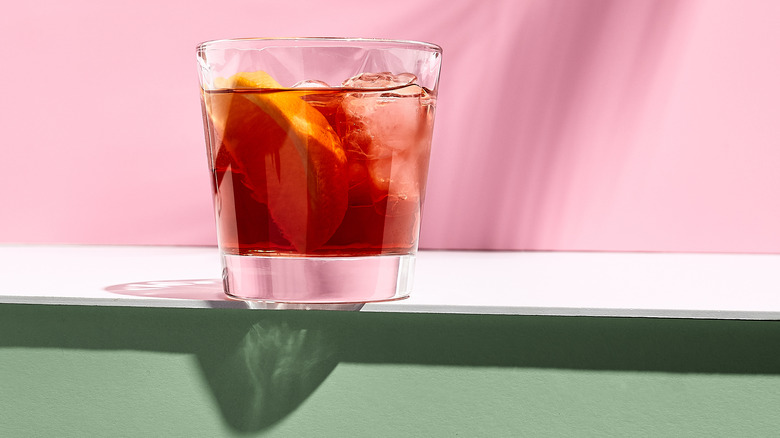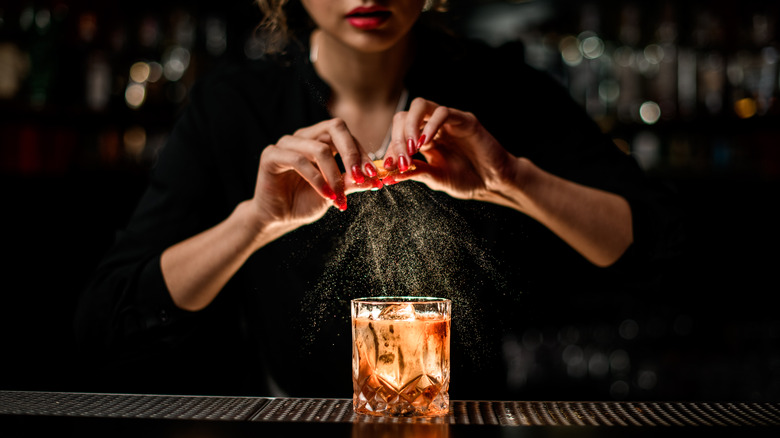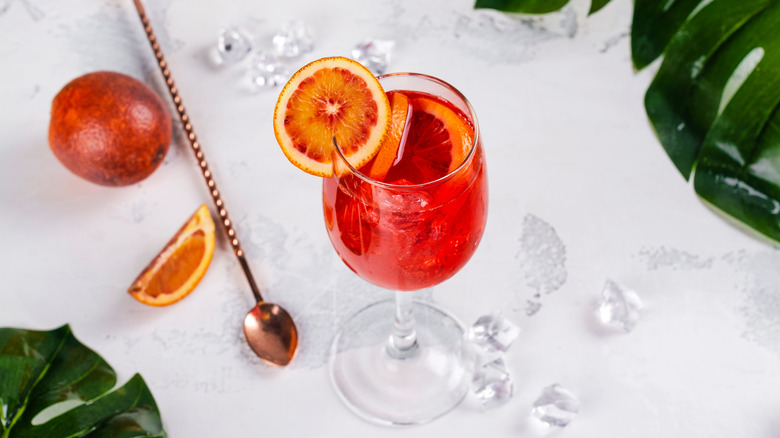14 Campari Alternatives To Sip On Next
If you've ever sipped on a Negroni or an Aperol Spritz — perhaps on a warm sunny day lounging in a picturesque piazza — you've experienced the delight of what's known as a red bitter. This category of liqueurs encapsulates a wide variety of products made across the globe, with Italy's Campari being arguably the most famous. As Skurnik Wines & Spirits explains these crimson elixirs evolved from humble, locally crafted herb-infused wines and spirits to the almost neon-hued products that grace today's bar shelves, and are integral in so many modern cocktails.
There are countless variations of this style of liqueur that range from sweeter to more bitter, lighter to more alcoholic, and each has its own proprietary recipe. Some are kept secret, but most have similar botanical ingredients whose signature flavors and aromas are easily distinguishable with a quick sniff or sip. There are so many red bitters on the market these days, it can be difficult to know what to choose — that's where this helpful guide comes in. If you love Campari but are looking for something new to try, take a look at these alternatives.
Aperol
Vibrant orange, refreshingly cool, and just a touch fizzy, the Aperol Spritz is popular with hardcore mixology enthusiasts and casual imbibers alike. It's hard to imagine a more perfect summertime drink, a more invigorating sip after a long day, or a better brunch beverage. The Aperol Spritz is truly having a moment right now — although as Town & Country points out, the cocktail has been around for decades — but Aperol itself is much more than just a spritz ingredient. It's an impressively versatile liqueur that can be used in place of Campari, but has a personality all its own.
Whereas Campari's alcohol by volume, or ABV, is more than 20%, Aperol clocks in at a much lighter 11% ABV. This is one reason why the Aperol Spritz works well as a brunch and afternoon drink — its lower alcohol content means it won't knock you out for the rest of the day. When it comes to taste, Aperol sits on the sweeter side of the sweet-bitter spectrum compared to Campari, although it still does express bitter notes along with prominent flavors of oranges and herbs.
Aperitivo Cappelletti
Near the charming village of Trento in mountainous northern Italy, the Cappelletti family has been making liqueurs using local botanicals since the early 20th century, according to Haus Alpenz. Their Aperitivo Cappelletti, known by its nickname "Il Specialino" in its native region, is a great Campari substitute to sip on. At 17% ABV, it's a touch lighter than Campari, but has a bit more heft than Aperol.
Cappelletti's main selling point is its dryness. Like all examples of this style of liqueur, it has sweetness too, but it focuses on the balance between sweet and bitter. It's got a finish that's dry rather than sugary, with a zesty citrus note that makes it extra refreshing in a spritz and other cocktails. While prices vary in different markets, Aperitivo Cappelletti also tends to be lower priced than many of its competitors, which coupled with its quality, makes it an excellent value to seek out.
Contratto Bitter
Contratto Spirits lies in the Piedmont region of northern Italy, famous for its lauded fine wines like Barbaresco and Barolo. In fact, Contratto began as a winery in 1867, as discussed on their website, crafting sparkling wines that became popular throughout the world. They started creating vermouths and liqueurs in 1920, which are still made using virtually the same recipes and processes today. One of these liqueurs is Contratto Bitter, which can be easily used as a Campari substitute for both sipping and cocktail creation.
Contratto uses natural and vegan ingredients for both flavor and color of its red bitter. While you may wonder what element of a liqueur may not be vegan, there are some red bitters that use a coloring agent called cochineal to achieve their color, which is made from beetles, according to Difford's Guide – Contratto uses beetroot and carrot instead to get their signature red hue. In addition, the brandy that serves as the liqueur's base is distilled from grapes grown in their own vineyards. This allows optimum quality control from start to finish.
You can sense the care and craftsmanship that goes into Contratto bitter. It's a nicely balanced example of the style, with intense flavor that comes from 24 different herbal extracts. Its complexity lends it well to sophisticated cocktails like the Boulevardier.
Bordiga Bitter
Near the Alpine city of Turin in northern Italy lies the Bordiga distillery. Started by an herbalist named Pietro Bordiga in the late 19th century, according to Oliver McCrum, Bordiga crafts spirits, vermouths, and liqueurs utilizing the bounty of local botanical ingredients grown throughout the mountainous region. Their red bitter liqueur is comparable to Campari in style and alcohol content, but has its own unique character.
One of the things that sets Bordiga's products apart is their intricate process for procuring and infusing their ingredients. The majority of the flowers, herbs, and roots used in their red bitter are foraged from the surrounding area, and each is treated individually to best extract its flavor. They are then blended into the final product with expertise and artistry to create just the right layers and balance of flavors. Both the flowers and roots of the gentian plant are used prominently, known for their bitter flavor. They're balanced by bright citrus and dozens of other botanicals to create the liqueur's signature complex flavor profile. You can make a Negroni using only Bordiga products by using this red bitter, Bordiga Vermouth, and Occitan Gin.
Pur Spirits Zamaro Aperitivo
Lest you think red bitters are exclusively Italian, let's take a jaunt to Germany. Pur Spirits creates a red bitter called Zamaro from local Bavarian botanical ingredients, using only natural products. This Aperitivo is very subtly sweetened which allows the nuanced botanical flavors to really shine. It also allows for lots of versatility in cocktails, as it's always easier to add sugar than to take it away. So if you're someone who enjoys your drinks less sweet, this is a great Campari alternative to try.
Pur Spirits plays it rather cagey when it comes to disclosing the actual botanicals used in their Zamaro, but it's immediately obvious that plenty of flowers are involved. The nose is intensely perfumed with exotic and delicate floral notes as well as the more standard citrus and herb aromas that are common with this style of bitter. The unique bouquet of this liqueur makes it perfectly enjoyable to sip on its own, over ice with a splash of soda to bring out its flavors — it doesn't need much embellishment.
Gajardo Bitter Radicale
Gajardo Bitter Radicale is a relatively new product, although it's made by Distilleria Schiavo in the Veneto region, which has been making grappas and other distillates for five generations, as Veneto Secrets discusses. This particular recipe was crafted in 2014 in an attempt to create a first-rate red bitter that used classic techniques and all natural ingredients. By all accounts, the development was a success — the World Liqueur Awards crowned it the world's best bitter in 2019.
To create Bitter Radicale, the proprietary blend of herbs, spices, and other botanicals is infused into the base spirit for a minimum of 18 days and then stirred using a process called bâtonnage to release their flavors and aromas. At 25% ABV, Gajardo Bitter Radicale is one of the stronger red bitters on the market, comparable to Campari in that sense. Its bitterness is pronounced, yet not overwhelming, and it's known for its signature balsamic note and prominent spiciness. Try it in a Mescal Negroni.
Leopold Bros Aperitivo
Run by two brothers, Leopold Bros. is a prolific distillery located in Denver, Colorado. While they produce spirits like gin, whiskey, and vodka, they're perhaps best known for their extensive line of liqueurs made with fresh, natural ingredients, including their Aperitivo. Similar to Campari in style and flavor profile, it's bottled at 24% ABV and can be easily used as a Campari substitute in cocktails.
Gentian's bitterness is very apparent in this Aperitivo, balanced by sweetness from cane sugar. There's a prominent citrus flavor of grapefruit that contributes to the bitterness but also adds a bracing freshness to the liqueur. Another notable ingredient is Artemisia pontica, a species of wormwood that's known for its inclusion in absinthe and vermouths, as Alcohol Professor discusses, which can add bitter, herbaceous, and woody flavors. The grapefruit flavor pairs nicely with more citrus — squeeze some oranges, and try it in a Garibaldi.
Del Professore Bitter
In the center of Rome down a narrow side street lies a speakeasy called Jerry Thomas. It's named after the legendary 19th century New York bartender whose influence is still felt in the bar and mixology world today, as Difford's Guide discusses, and who was nicknamed "the Professor." Together with the distillers at Antica Distilleria Quaglia, the Del Professore line of vermouths, liqueurs, and spirits was created by the bar in an attempt to craft the highest quality products to elevate their cocktails. One of these items is the Del Professore Bitter, a Campari alternative that showcases the impeccable craftsmanship that goes into these exceptional products.
Intensely bitter yet somehow still well balanced, Del Professore's Bitter is just as enjoyable to sip on its own as it is mixed into cocktails. Flavors of orange peel and warm sweet and savory spice abound, along with a bitter rhubarb taste and the classic note of gentian. There's also a strong note of juniper, which makes it a particular complementary pairing with gin. A delightful, perfectly balanced Negroni can be made with Del Professore's gin and vermouth from the same line of products.
St. Agrestis Inferno
As its name implies, the Inferno bitter by St. Agrestis is not messing around. Based in Brooklyn, St. Agrestis first made their name by selling ready to drink bottled Negronis. It wasn't until 2019, according to The New York Times, that the bitter element — the Inferno — was bottled and sold separately. It clocks in at the standard Campari-esque 24% ABV and boasts all natural ingredients and organic botanicals.
The bitterness of the Inferno is not shy. It's definitely got a kick, but not an unpleasant one. All three of the main elements of this style are there: floral, citrus, and bitterness play off of each other nicely. Because of its intensity, it's best enjoyed in a cocktail, although you can sip it on its own, too, if you're in the mood for a big punch of flavor. Because it can hold its own with other intense ingredients, it's great in classic tiki drinks. Swap the Campari out for Inferno in this Jungle Bird variation, the Jungle Cat.
Montenegro Select Aperitivo
Montenegro may be best known for their popular Amaro, affectionately known as "Monty" to its fans. But they also offer a red bitter that was created all the way back in 1920, which has its own spritz recipe: the Venetian Spritz, which is made with Select Aperitivo and traditionally garnished with a speared olive. The liqueur's usage in a spritz makes sense, as it's closer in style, flavor, and alcohol content to Aperol than it is to some of the other higher ABV selections on this list, including Campari. But it can still be used as a Campari substitute, too, if you want a softer, less bitter element in your drink.
Select Aperitivo has relatively low ABV and a subtle bitterness that's balanced by a delicate sweetness, making it an easy-drinking liqueur to sip on. But there's also a deep complexity to it if you take your time and appreciate each sip, thanks to the 30 different botanical ingredients including juniper and rhubarb for sharp herbal character, and a sweet and soothing note of vanilla to round things out. It's definitely worth tracking down if you're a spritz fanatic.
St. George Bruto Americano
Bruto Americano, made by St. George Spirits in Alameda, California, is a force to be reckoned with. It leans unapologetically into the bitter side of things, with dimensions of earthy, wild, and savory flavors and just enough sweetness to make it palatable. If you're a fan of the bitter elements of this style of liqueur but don't like too much fruitiness, Bruto Americano may just be the Campari alternative you're looking for.
That's not to say it's unpleasant to drink — not at all. There are lots of zesty citrus and comforting warm spice notes that complement the rustic earthy flavors and bitter sensations, and because it's only lightly sweetened, you can customize it to suit your desired level of sweetness in any drink you make. While its exact botanical formula is kept secret, it involves many local California ingredients including balsam fir and buckthorn bark, along with California-grown oranges, to give it a unique regional flavor profile. St. George also makes a line of gins, which pair beautifully with the Bruto Americano in cocktails.
Luxardo Bitter Rosso
The evolution of Luxardo as a brand has a long and storied history, as their website discusses, beginning with the birth of their version of maraschino liqueur inspired by a classic Dalmatian recipe. Amazingly, this liqueur is still prominently used in bars and cocktails today, roughly 200 years later. But Luxardo makes much more than that, including a red bitter that's a great alternative to Campari.
Luxardo's Bitter Rosso is a classic example of the style, with gentian as the primary driver of bitterness, wormwood to enhance it, and plenty of bright citrus and aromatic herbs to round out the aromas and flavors. Its bitterness and sweetness are both prominent but in balance, with neither overwhelming the other. Orange is the main citrus flavor, along with some grapefruit notes. This red bitter is about as traditional as you can get, very similar in style and flavor profile to Campari. If you're a fan of the tried-and-true, this might be the perfect Campari alternative for you.
Faccia Brutto Aperitivo
Faccia Brutto was started by chef Patrick Miller in Brooklyn in 2020. The young distillery makes a line of Italian-inspired liqueurs including an Aperitivo, which lies somewhere between Campari and Aperol on the bitterness and flavor scale. At 24% ABV, it has the body and alcohol of Campari, along with the pronounced gentian bitterness, while it also showcases juicy orange citrus and a nice dose of cane sugar sweetness reminiscent of Aperol.
It's versatile and well balanced, with a touch of salt, a little flourish you'd expect from a lifelong chef. The herbs and spices are pleasantly aromatic but not overwhelming, which makes this Aperitivo adaptable to all kinds of cocktails. Its middle of the road quality makes it a great choice for your home bar, as it'll match up well with whatever spirits you happen to have on hand. Or, just enjoy its pleasant balance on its own with a peel of orange to enhance its citrus character.
Meletti Bitter Aperitivo
If you're not one to shy away from sweeter drinks, Meletti might have the perfect Campari alternative for you. The prolific Italian liqueur company has a vast line of products, from coffee liqueur to multiple styles of anisette, and even a creamy chocolate punch (which, if you happen to cross its path, is fantastic poured over vanilla ice cream). All of their products are based on traditional Italian liqueur recipes, including their red bitter.
Meletti's Bitter Aperitvo is among the sweetest offerings in this guide, but it's not without balance. There's definitely gentian which shows up on the palate, and plenty of spices to create complexity. A combination of both bitter orange and sweet orange give this liqueur a fruitier profile than many of the others. It has a pure juicy citrus component that lets it work as a before or after dinner treat, if one were so inclined to pair it with a fruit-based dessert, like this Mandarin Cake.
